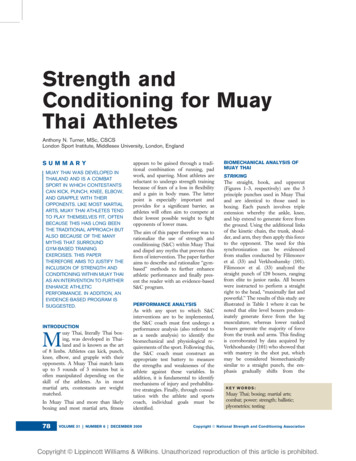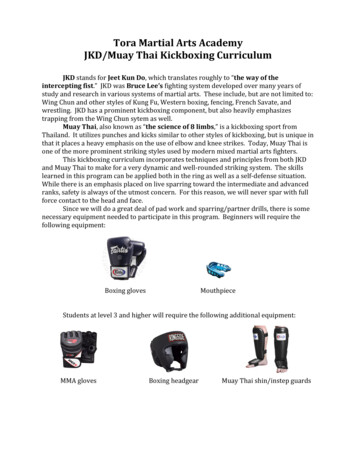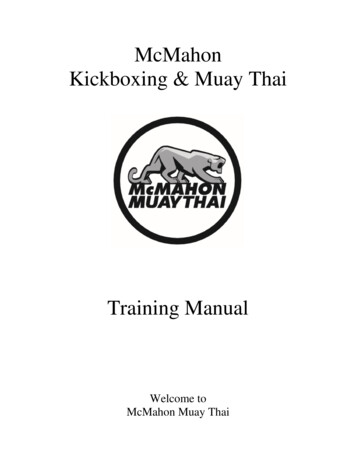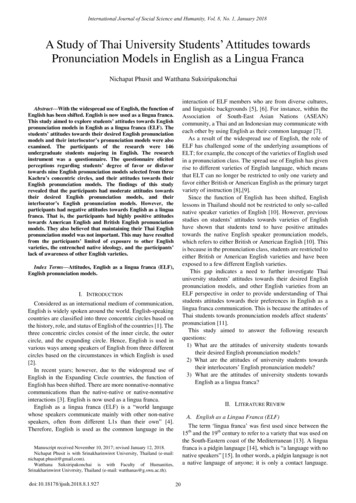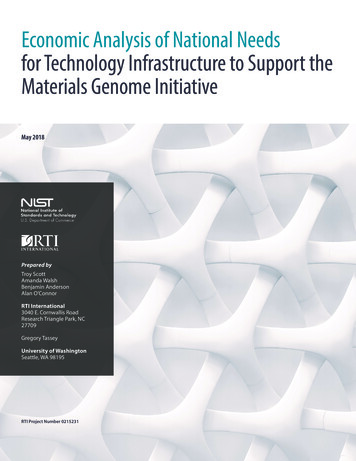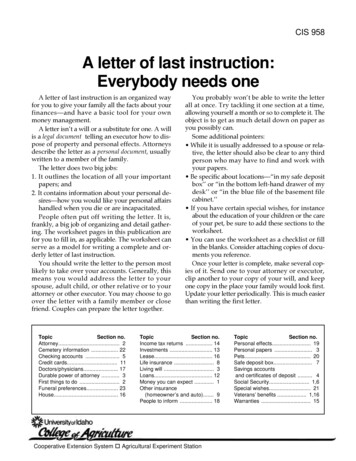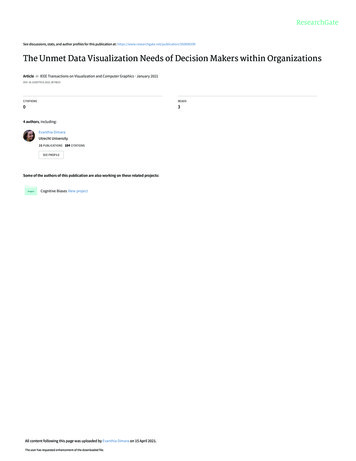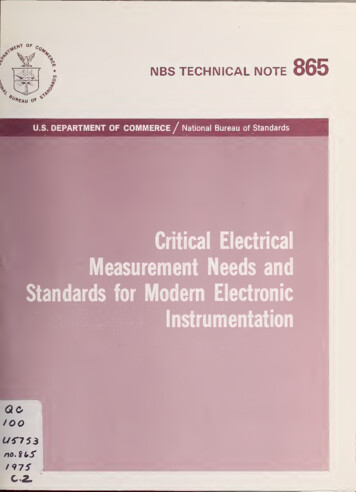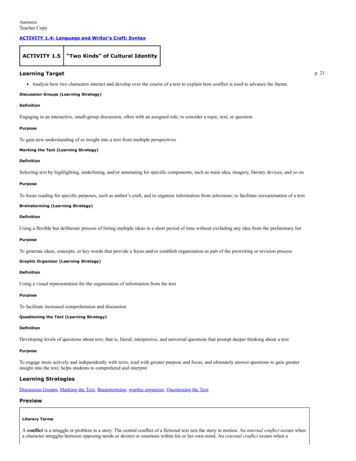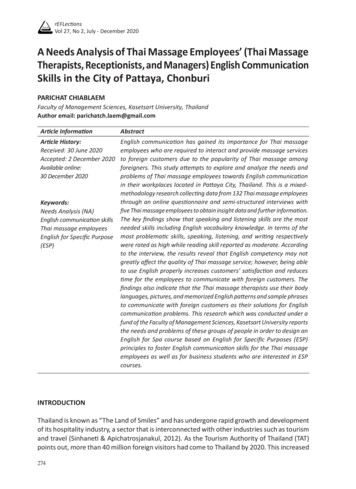
Transcription
rEFLectionsVol 27, No 2, July - December 2020A Needs Analysis of Thai Massage Employees’ (Thai MassageTherapists, Receptionists, and Managers) English CommunicationSkills in the City of Pattaya, ChonburiPARICHAT CHIABLAEMFaculty of Management Sciences, Kasetsart University, ThailandAuthor email: parichatch.laem@gmail.comArticle InformationAbstractArticle History:Received: 30 June 2020Accepted: 2 December 2020Available online:30 December 2020English communication has gained its importance for Thai massageemployees who are required to interact and provide massage servicesto foreign customers due to the popularity of Thai massage amongforeigners. This study attempts to explore and analyze the needs andproblems of Thai massage employees towards English communicationin their workplaces located in Pattaya City, Thailand. This is a mixedmethodology research collecting data from 132 Thai massage employeesthrough an online questionnaire and semi-structured interviews withfive Thai massage employees to obtain insight data and further information.The key findings show that speaking and listening skills are the mostneeded skills including English vocabulary knowledge. In terms of themost problematic skills, speaking, listening, and writing respectivelywere rated as high while reading skill reported as moderate. Accordingto the interview, the results reveal that English competency may notgreatly affect the quality of Thai massage service; however, being ableto use English properly increases customers’ satisfaction and reducestime for the employees to communicate with foreign customers. Thefindings also indicate that the Thai massage therapists use their bodylanguages, pictures, and memorized English patterns and sample phrasesto communicate with foreign customers as their solutions for Englishcommunication problems. This research which was conducted under afund of the Faculty of Management Sciences, Kasetsart University reportsthe needs and problems of these groups of people in order to design anEnglish for Spa course based on English for Specific Purposes (ESP)principles to foster English communication skills for the Thai massageemployees as well as for business students who are interested in ESPcourses.Keywords:Needs Analysis (NA)English communication skillsThai massage employeesEnglish for Specific Purpose(ESP)INTRODUCTIONThailand is known as “The Land of Smiles” and has undergone rapid growth and developmentof its hospitality industry, a sector that is interconnected with other industries such as tourismand travel (Sinhaneti & Apichatrosjanakul, 2012). As the Tourism Authority of Thailand (TAT)points out, more than 40 million foreign visitors had come to Thailand by 2020. This increased274
rEFLectionsVol 27, No 2, July - December 2020number of tourists coupled with the growing importance of hospitality has led to a high demandfor employees who can communicate effectively in English. English has become an internationallanguage. Therefore, people around the world use English as a means of communication indifferent aspects of life such as education, travel, music, science & technology, work, andbusiness (Luankanokrat, 2011). Business English proficiency has become a crucial factor indetermining whether or not a business is successful. This is especially true for internationalbusinesses (Zahedpisheh, 2017). As Patanasorn et. al. (2018) elaborates, customer satisfactionand the quality of services are based on employees having effective English communicationskills.In addition, according to the National Strategy for Thailand 4.0 and the National Economic andSocial Development Plan, the Eastern Economic Corridor (EEC) has been introduced in a majoreffort to develop and invest in the three-province development zone of Rayong, Chonburi, andChachoengsao. Within this area, the city of Pattaya, located in Chonburi, is one importanteconomically growing city that both Thais and foreigners have chosen for their travel destination(Suraprajit, 2017). Pattaya has gained popularity because of its tourist places, beaches, andentertainment, as well as its health tourism consisting of medical, wellness, and spa tourism.As a result, it is a key area where the needs and problems related to English communicationskills among massage businesses should be explored.Thai massage is a traditional medical healing method and is reflected in the people’s culture(Chia, 2005; Kanchanoo, 2012). It is claimed to be a ‘healing art’ and a traditional techniquefor the body that is related to Buddhist philosophy (Kogiso, 2012). Sawaddee (2016) makes aninteresting point in that Thai massage is becoming more successful as part of the Thai tourismindustry. As a result, Thai massage therapists are needed in Thai massage businesses. However,there are still many problems that Thai massage and spa therapists are facing, such ascommunicating in English with their customers (Patanasorn et. al, 2018).Previous studies have investigated the need for English communication in different careerssuch as Thai vendors working on Khaosan Road (Pruksanubal, 2006), employees at HSBC(Luankanokrat, 2011), and Thai nurses working in international hospitals accredited by JCI inthe Bangkok area (Chetsadanuwat, 2018). However, there are few studies examining the needsand problems of Thai massage employees in regards to speaking English. To be noted, thereis one study conducted by Patanasorn et al. (2018) that examined English needs among spaand massage therapists, receptionists, and customers. The study was conducted using threegroups of participants in the city of Khon Kaen. The study revealed that the most neededEnglish communication was related to asking customers questions during the massage process.These included greeting customers, asking about pain, and asking customers to change positions.Customers needed information about the massage program and information about pain. Thestudy provided information from the customer’s point of view as well as the point of view ofthe spa and massage workers. However, for the present study, the researcher aimed toinvestigate the insights and perspectives of massage employees–a group of people workingwith foreign customers in the Pattaya area–in order to understand their true needs andproblems.275
rEFLectionsVol 27, No 2, July - December 2020In order to solve communication problems and improve the quality of Thai massage servicestandards, it is very important to examine the problems and find ways to improve Englishcommunication skills for Thai massage employees. An English for Specific Purposes (ESP)knowledge and needs analysis plays a crucial role in the decision-making process of Englishlearning and for planning materials that can be used by Thai massage employees who workin Pattaya, Chonburi. The results of this research will be very useful for many sectors inunderstanding these needs and problems. The Pattaya municipality, ESP curriculum and coursedevelopers, Thai massage businesses, and business students who are interested in Englishcommunication in Thai massage shops can all benefit from this research.Research questions1. To what extent do Thai massage employees (Thai massage therapists, receptionists, andmanagers) in the city areas of Pattaya need English communication skills?2. What English communication problems do Thai massage employees (Thai massage therapists,receptionists, and managers) in the city areas of Pattaya encounter when communicatingin English in the workplace, and what are the causes of the problems?3. What are learning topics to be covered by an English course for Thai massage employees?Objectives of the study1. To analyze the needs of Thai massage employees (Thai massage therapists, receptionists,and managers) in the city areas of Pattaya in terms of English communication in theircareers.2. To examine English communication problems of Thai massage employees (Thai massagetherapists, receptionists, and managers) in the city areas of Pattaya when communicatingin English in the workplace.3. To suggest learning topics that should be included in an English course for Thai massageemployees.Scope of the studyThis research focused on Thai massage employees who work in Thai massage shops locatedin Pattaya, Chonburi in order to investigate the needs of Thai massage employees there andindicate whether there are English communication problems. The samples used in the studywere 132 Thai massage employees for the questionnaire, and five Thai massage employees(Two Thai massage therapists, two receptionists, and a manager) served as representatives toprovide further information in the interview.LITERATURE REVIEWEnglish for Specific Purposes (ESP)English for Specific Purposes (ESP) has become one of the most important branches of Teaching276
rEFLectionsVol 27, No 2, July - December 2020English as a Foreign Language (TEFL) and generally falls into the Applied Linguistics field. Thedevelopment of English for Specific Purposes (ESP) had begun since the early 1960s and 1970swhen there was a shift from a linguist-based curriculum to a functional curriculum. Englishlanguage was studied in the contexts of use rather than the linguistic dimensions of thelanguage. As Hutchinson & Waters (1987) point out, there are three main reasons of theemergence of ESP which are an increase of technology and commerce after World War II, thedevelopment of linguistics, and the learner-based approach.To begin with, English has become a very crucial language in the world. As a result, there is aneed for good English competency, which brings about a necessity for teaching and learningEnglish in different situations and for various purposes. General English courses in schools oruniversities have not only taught elements of English grammar or linguistics, but have alsoevolved to serve real world requirements. As Robinson (1991) and Dudley-Evans (1998) pointout, the needs of EFL learners are mostly related to skills and language suitable for theirprofession, future profession, or specific lines of work. Therefore, in ESP instruction, themethods and content are based on the reasons for learning (Hutchinson & Waters, 1987).For these reasons, ESP courses are designed for occupational purposes and job requirementssuch as for airline staff, international operators, or international companies’ employees, guides,spa therapists, etc. Moreover, ESP teaching and learning materials are created from the learners’needs and problems. They are related to real-world situations and the learners’ workplaces.According to Robinson (1980), ESP course is considered as a goal-oriented course which thelearners do not only learn the language but also the way to use it for their careers or theiracademic degrees. Importantly, with different groups of learners, the teachers need tounderstand their learners’ needs, so that their needs analysis is included within the curriculumdevelopment. Thus, needs outcomes are beneficial for the teachers in designing a suitablecourse, as well as creating materials for teaching and testing.Needs Analysis (NA)Needs Analysis (NA) is used as a tool to collect and evaluate information which is related tocourse designing (Flowerdew, 2013). This refers to the learners’ backgrounds and goals, theirreasons for learning, their language proficiencies, their teaching and learning preferences, andthe situations in which they need to communicate. These factors influence the teachers orcourse developers to focus on the needs of the learners as their main objective. Moreover,needs analysis is used to demonstrate the learners’ perspectives, provide useful data fromvarious sources, and offer detailed information. Richard (1986) also suggests that needs analysishelps to define the general and specific language needs used to design a learning course withsuitable objectives, goals, and content. In addition, as Lawrence et al. (1991) point out, theuse of surveys to examine problems of a target group in detail can depict the potential solutionsby comparing the present situations to the preferred situations.According to Hutchinson & Waters (1987), ESP defines ‘target needs’ and ‘learner needs.’ Targetneeds are described by Hutchinson & Waters (1987) as being what learners need to do in thetarget situation in order to succeed in communicative purposes. To elaborate more on this,277
rEFLectionsVol 27, No 2, July - December 2020the target needs can be categorized into three aspects. Firstly, ‘necessities’ which means whatlearners need to know in order to perform well in the target situation. Secondly, ‘lacks’ whichrefers to the absence of learners’ necessities. Lastly, ‘wants’ which are related to the requirementof learners. Apart from these types of needs to be considered, the educational backgroundsof the learners are important in terms of their job requirements, the necessity of their Englishlearning, and their lack and/or need of English competency (Robinson, 1991). The key toanalyzing the learners’ needs is not only knowing ‘what the learners need to learn’, but also‘How will the learners learn?’ (Hutchinson & Waters,1987).Another important point about needs analysis is its process. The researcher can follow theprocess in order to investigate and search for the needed information. Grave (2000:100)introduces the steps of needs analysis as follows: decide what information to gather and why;decide when, from whom, and how to gather it; gather information; interpret it; act on it; andevaluate the effects of the action.Curriculum and course designAs Cater (1983) points out, three common characteristics of an ESP course are: materialauthenticity, purpose-related orientation, and self-direction. In the target situation, an ESPcourse should apply authentic materials, as well as interactive activities and tasks that providea simulation of target situations where needed language is used. Most importantly, studentsshould be trained to be English users rather than learners. To design an effective E
Thai massage is a traditional medical healing method and is reflected in the people’s culture (Chia, 2005; Kanchanoo, 2012). It is claimed to be a ‘healing art’ and a traditional technique . for the body that is related to Buddhist philosophy (Kogiso, 2012). Sawaddee (2016) makes an . interesting point in that Thai massage is becoming more successful as part of the Thai tourism industry .
